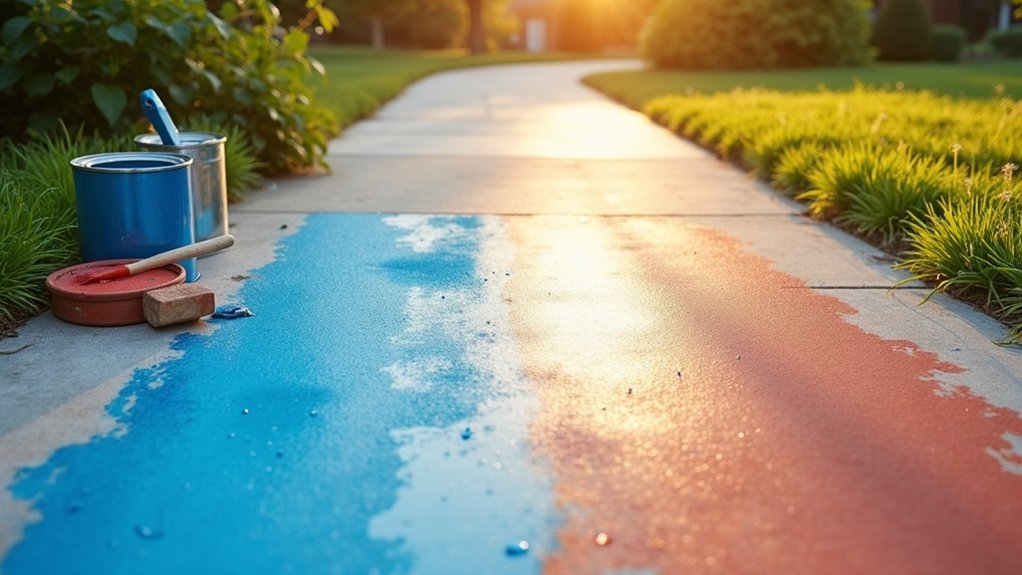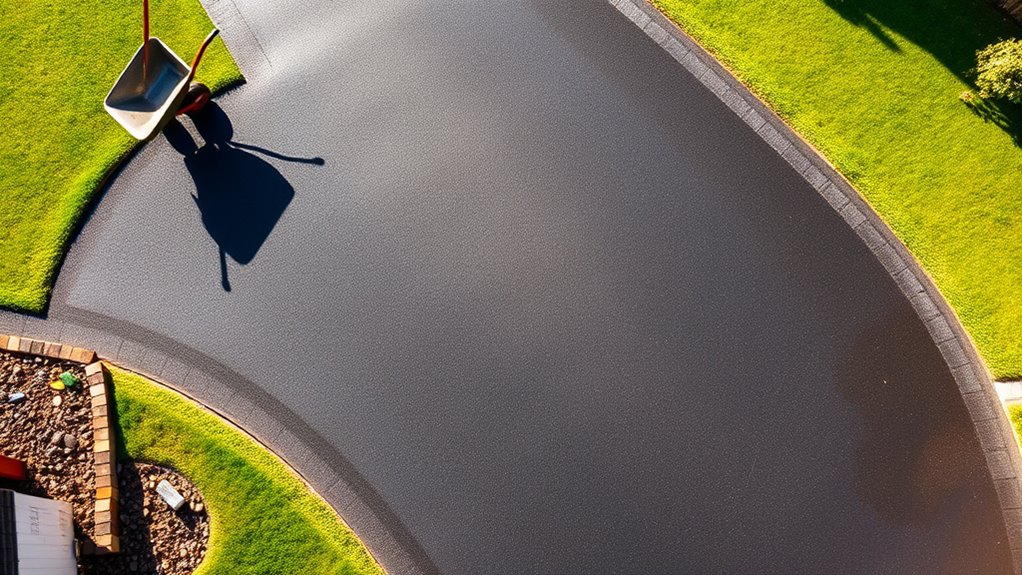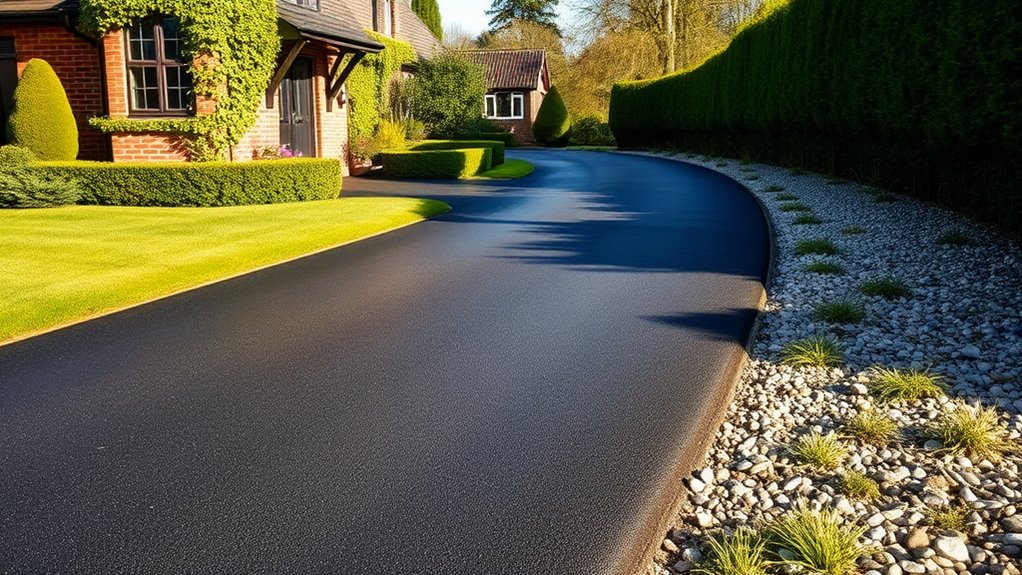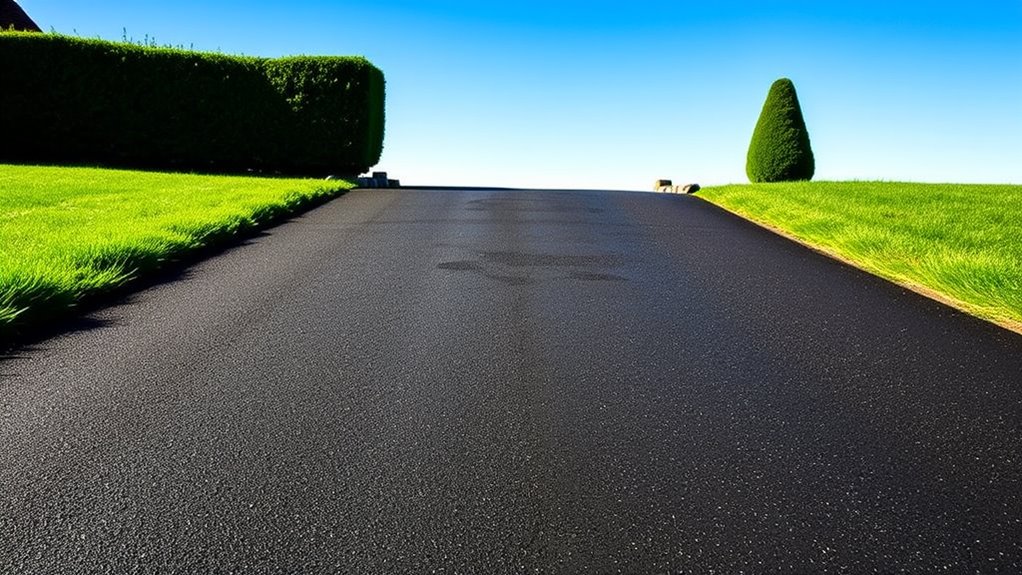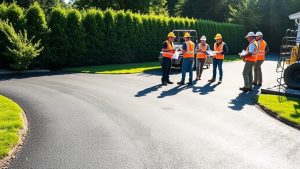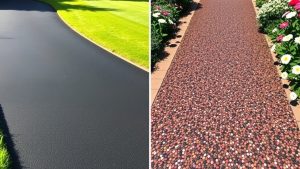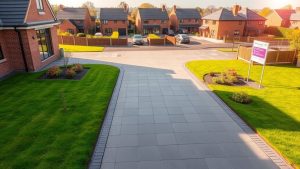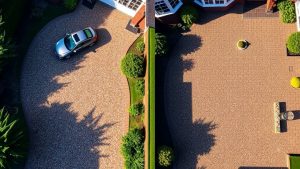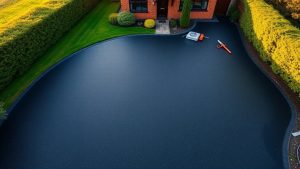Yes, you can paint a concrete driveway! It enhances the appearance and offers protection against the elements while allowing for personalised design options. However, there are downsides, such as the risk of chipping and the necessity for proper surface preparation. You may need to maintain painted surfaces every 2 to 5 years, but it’s generally more cost-effective than resurfacing. If you want to delve deeper into the pros and cons, keep exploring this topic for more insights!
Table of Contents
ToggleKey Takeaways
- Painting a concrete driveway can significantly improve its appearance and protect it from UV rays and chemical stains.
- Different types of paint, such as epoxy and acrylic, provide durability and weather resistance, making them ideal for driveways.
- To maintain the quality of the painted surface, it’s essential to reseal it every 2-3 years.
- While painting is more affordable than resurfacing, be prepared to apply fresh coats every 2-5 years for the best results.
- Proper surface preparation is vital to prevent issues like chipping and peeling, ensuring a long-lasting finish.
Benefits of Painting a Concrete Driveway
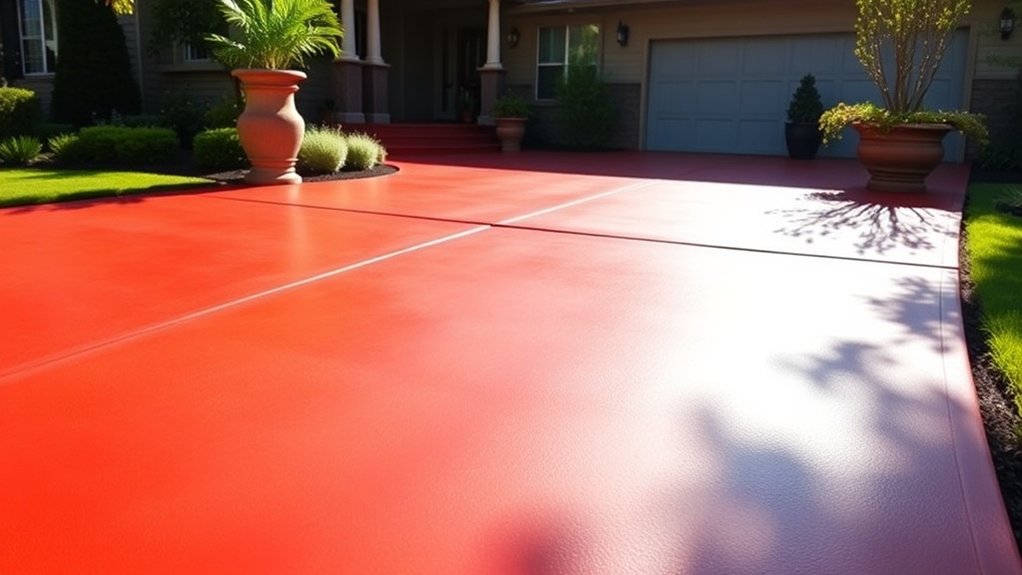
When you paint your concrete driveway, you’re not just improving its look; you’re also investing in its longevity and functionality. A protective layer enhances the driveway’s appearance while shielding it from environmental damage. The paint acts as a sealant, protecting against harmful UV rays, water absorption, and chemical stains, which can save you from expensive repairs. Moreover, a painted surface helps prevent mould growth and makes it easier to spot cracks. Enhanced visual appeal with a variety of color options also allows you to customize your property’s look. With the right upkeep, your driveway can last longer than average, ultimately saving you money. In short, the benefits of painting—such as greater durability and lower maintenance—make it a wise choice for your property’s value and your peace of mind.
Aesthetic Improvements
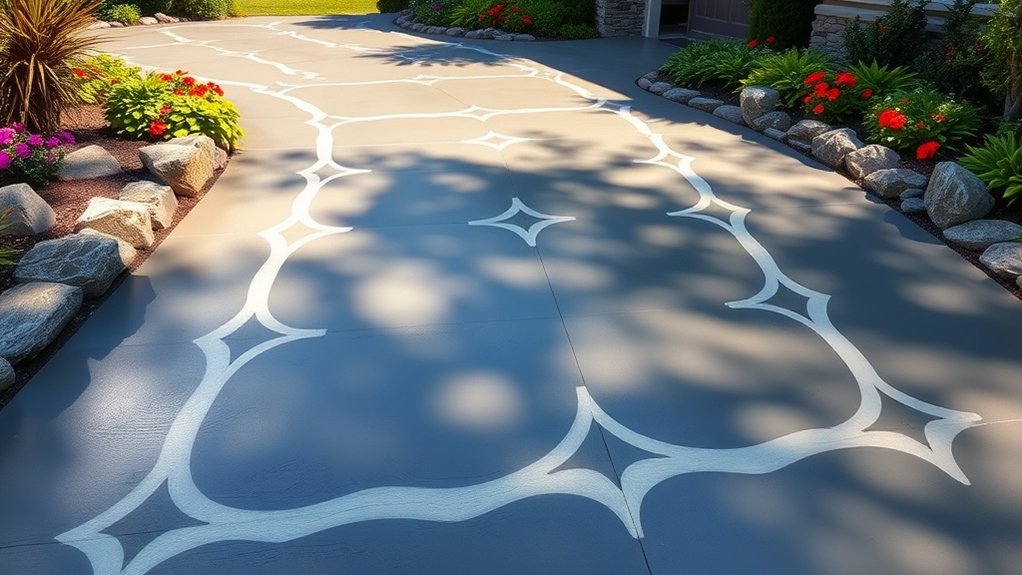
Painting your concrete driveway opens up a range of colour options and design opportunities that can significantly boost your home’s curb appeal. Whether you prefer classic neutrals or bold shades, you can achieve a look that showcases your personal style. Adding patterns or geometric designs can also turn a simple surface into a striking feature that catches the eye. Additionally, using DRYLOK® products can enhance the longevity and durability of your painted driveway while providing aesthetic improvements.
Color Customization Options
Colour customisation options for your concrete driveway not only enhance its visual appeal but also allow you to showcase your personal style and complement your home’s exterior.
Popular choices include grey for a contemporary look or warm earth tones for a more rustic vibe, both of which can significantly improve curb appeal. Consider the impact of colour psychology—darker shades like charcoal can convey sophistication, while lighter hues create a welcoming atmosphere. Additionally, Timeless Gray is a leading choice for homeowners looking to achieve a polished look that pairs well with a variety of architectural styles.
You might also want to explore current trends, such as beige or terracotta, to harmonise with your landscaping. Custom colour matching services can help you achieve your desired shade, ensuring your driveway stands out and aligns with your overall aesthetic. Personalising your driveway can create a beautiful and cohesive outdoor space.
Pattern and Design Choices
While you might imagine a basic concrete driveway, adding distinctive patterns and designs can turn it into a striking feature of your home. Options include decorative scoring for sleek lines, stamped patterns that imitate natural stones for a touch of elegance, or acid stains that produce rich, varied colours. Textured surfaces provide not just visual interest but also added grip for safety. You can also use paint to highlight these designs, making your driveway truly stand out.
| Pattern Type | Benefits |
|---|---|
| Decorative Scoring | Contemporary look, helps prevent cracking |
| Stamped Patterns | Imitates natural stone, cost-effective |
| Acid Stains | Unique colours, adds depth |
| Textured Surfaces | Visual complexity, improves grip |
Protective Qualities of Paint
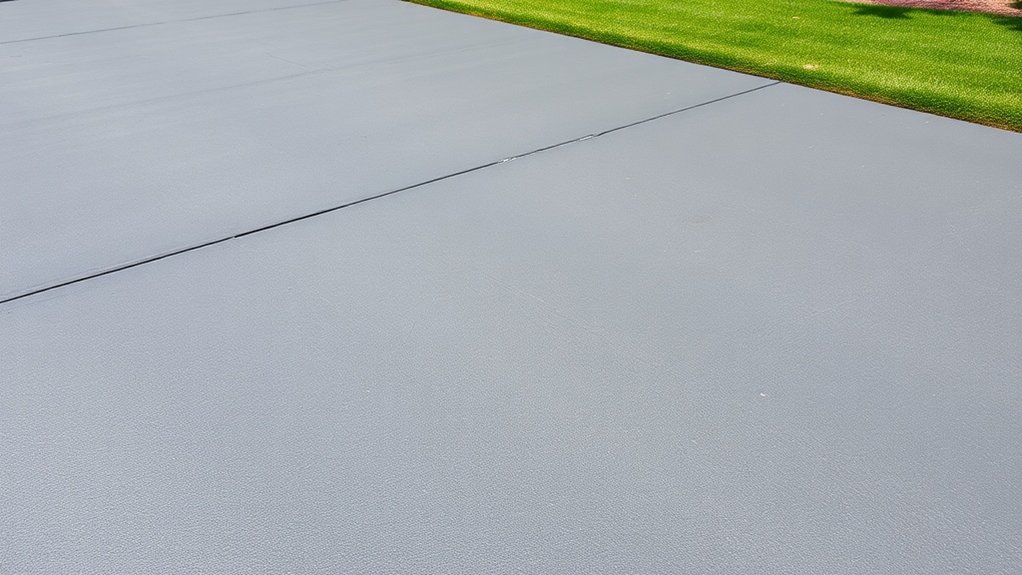
Painting your concrete driveway provides excellent weather resistance against the elements.
Coatings such as acrylic and polyurea not only protect against UV rays but also minimise damage from freeze-thaw cycles.
This extra layer of protection enhances durability, allowing your driveway to cope with heavy traffic and spills while keeping its appearance intact.
Weather Resistance Benefits
To protect your concrete driveway from the UK’s unpredictable weather, investing in high-quality weather-resistant coatings is essential.
These coatings offer UV protection, preventing fading and deterioration from sun exposure. They also shield against freeze-thaw cycles by preventing water penetration, which can cause cracks and spalling during colder months.
With effective moisture resistance, these coatings help avert mould growth and discolouration, ultimately reducing maintenance requirements. Additionally, they resist chemicals and salts that can harm the surface in winter.
Surface Protection Features
Investing in high-quality paint for your concrete driveway not only improves its look but also offers vital protection. The paint creates a visible barrier that seals the surface, guarding against moisture, dirt, and stains. This layer helps prevent water damage and minimises the risk of freeze-thaw cycles.
Many paints also resist common substances like motor oil and provide UV protection to combat sun damage. Coatings such as polyurea and polyaspartic are particularly effective, as they offer flexibility to accommodate expansion and contraction, reducing the likelihood of cracking.
Cost-Effectiveness Compared to Resurfacing
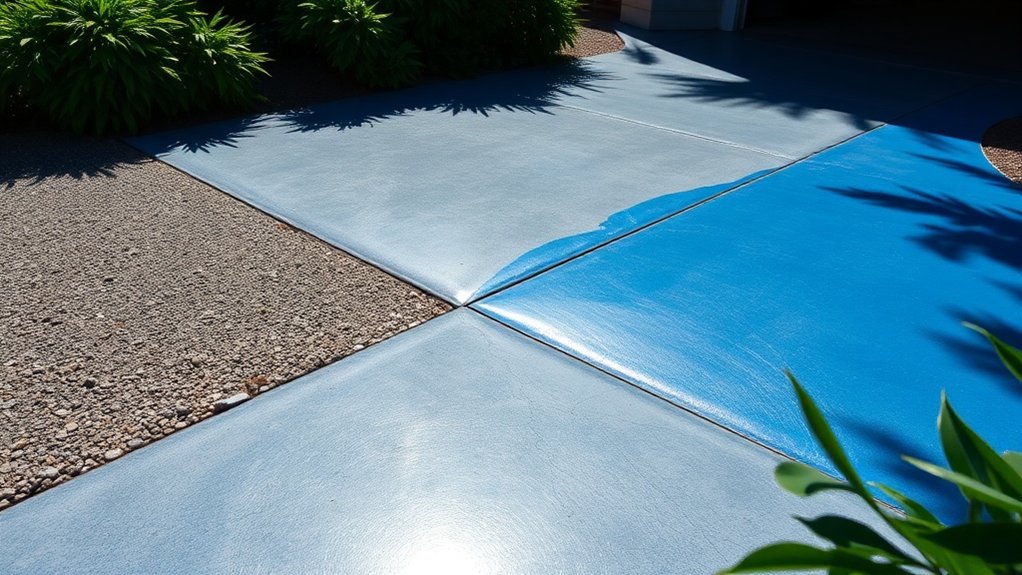
Deciding between painting and resurfacing your concrete driveway can significantly affect your finances. Here’s a straightforward cost comparison:
- Initial Costs: Painting is usually less expensive at the outset, while resurfacing costs between £20 to £35 per square metre due to the required preparation work.
- Longevity: A painted driveway typically needs a fresh coat every 2-5 years, leading to higher long-term expenses. In contrast, resurfaced driveways can last 5-10 years or longer.
- Labour Time: Painting usually takes just a day, keeping labour costs down, whereas resurfacing may take several days to complete.
While painting might appear to be the more economical option initially, resurfacing offers greater durability and lower maintenance over time, ultimately providing better value for your investment.
Customization Options
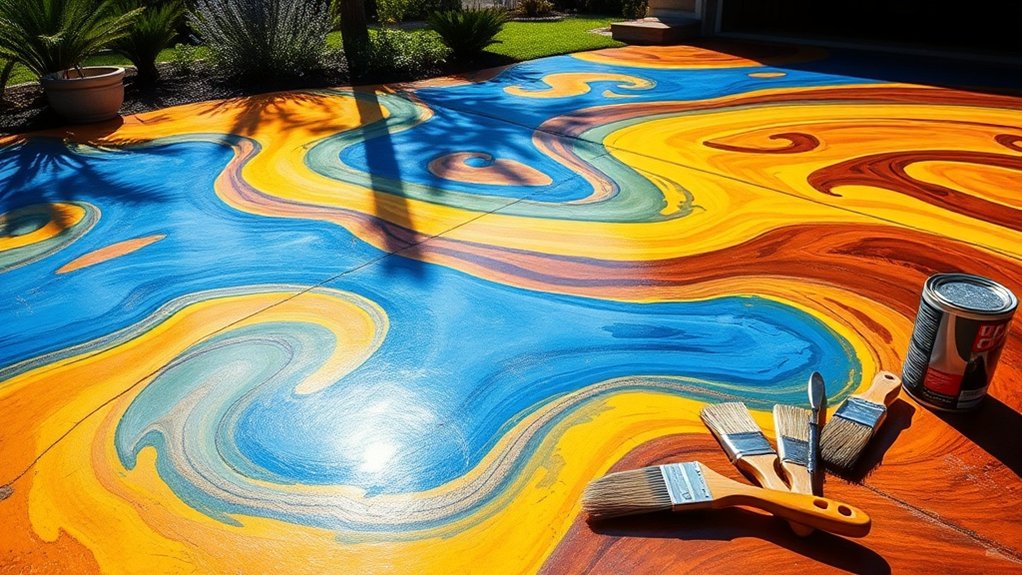
When it comes to customizing your concrete driveway, there are plenty of options to consider.
You can choose from a range of colours, design patterns, and finishes to ensure your driveway reflects your style.
Whether you prefer a sleek modern aesthetic or a textured, rustic look, these choices will help your driveway stand out and enhance the appearance of your home.
Color Selection Choices
There are numerous colour options for painting your concrete driveway, allowing you to tailor its look to complement your home’s style.
Here are some choices to consider:
- Neutral Tones: Shades like grey or beige offer flexibility and warmth, blending effortlessly with your property’s exterior.
- Bold Colours: Charcoal black adds a touch of sophistication and is effective at hiding dirt, while terracotta brings a rustic appeal.
- Specialty Shades: Consider custom colours that reflect your personal taste, ensuring your driveway stands out from the rest.
Design Patterns Options
How can you enhance the visual appeal of your concrete driveway? Consider geometric patterns, using shapes like triangles and hexagons for a contemporary look.
Stamped concrete is another option, mimicking natural stones such as cobblestone or slate, while offering durability at a lower cost.
For something different, try exposed aggregate, which showcases colourful stones and improves slip resistance.
Multi-pattern designs allow you to mix various textures and colours for a personalised touch.
Lastly, decorative overlays can introduce intricate patterns and textures to your existing concrete, giving it a fresh appearance without needing a full replacement.
With these choices, your driveway can be both practical and visually striking.
Finish Types Available
After considering various design patterns, it’s time to think about the different finish types available for your concrete driveway.
Each finish has its own texture and aesthetic, enhancing both functionality and style. Here are three popular options to consider:
- Exposed Aggregate Finish: This finish showcases stones, providing slip resistance and a textured appearance—ideal for safety.
- Broom Finish: It creates a rough surface, which ensures better grip during wet weather, making it a practical choice.
- Stamped Concrete: Designed to imitate natural materials, this finish offers decorative patterns whilst maintaining durability.
Selecting the right finish can significantly enhance your driveway’s look and performance, ensuring it complements your home and withstands the elements.
Take the time to explore these options to find the perfect mix of beauty and practicality for your concrete driveway.
Importance of Proper Surface Preparation
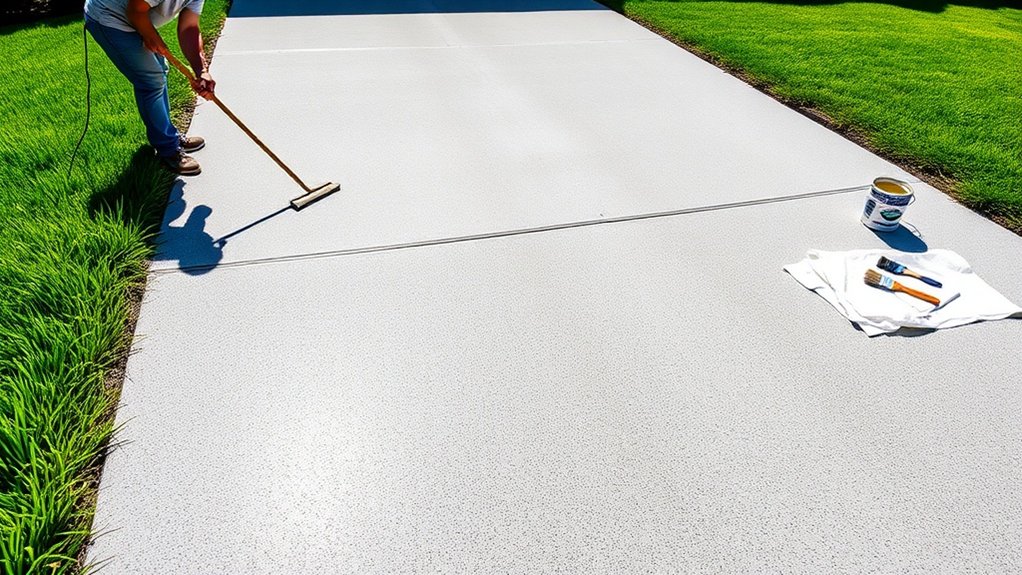
Proper surface preparation is vital for ensuring the longevity and durability of your painted concrete driveway. Begin by thoroughly cleaning the surface to remove dirt, grease, and oil stains, as this is crucial for paint adhesion. After cleaning, enhance the texture by etching the concrete, which opens the pores for better bonding. Be sure to repair any surface defects to achieve a smooth finish.
Here’s a quick summary:
| Step | Purpose |
|---|---|
| Surface Cleaning | Removes contaminants for better adhesion |
| Texture Enhancement | Creates a rough surface for improved grip |
| Repairing Defects | Prevents moisture penetration |
| Drying Conditions | Ensures no trapped moisture before painting |
Recommended Paint and Primer Types
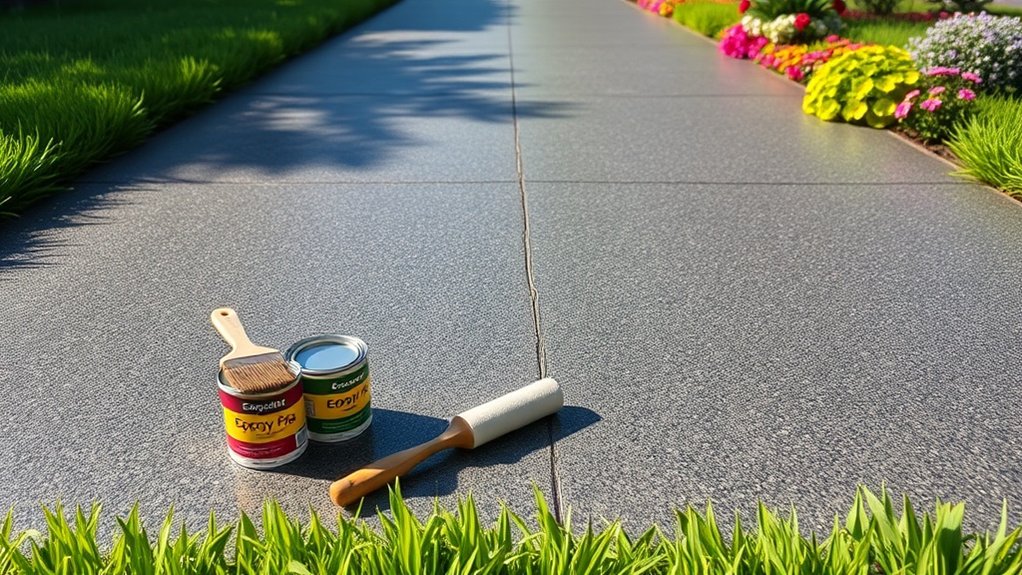
When selecting the right paint and primer for your concrete driveway, there are three primary types to consider: epoxy-based, acrylic-based, and latex-based paints. Each type has distinct benefits tailored to different needs.
- Epoxy Paints: Renowned for their durability and resistance to chemicals, epoxy paints offer a robust, long-lasting finish. Some formulations are self-priming, which means you won’t need a separate primer.
- Acrylic Paints: These paints are easy to use and provide UV resistance, making them ideal for outdoor applications. They dry quickly and are available in a wide range of colours.
- Latex Paints: Known for their ease of application, latex paints provide moderate durability. They’re low-odour and eco-friendly, often requiring just a single coat for effective coverage.
If you’re after something more specialised, consider exploring advanced coating options!
Application Techniques for Best Results
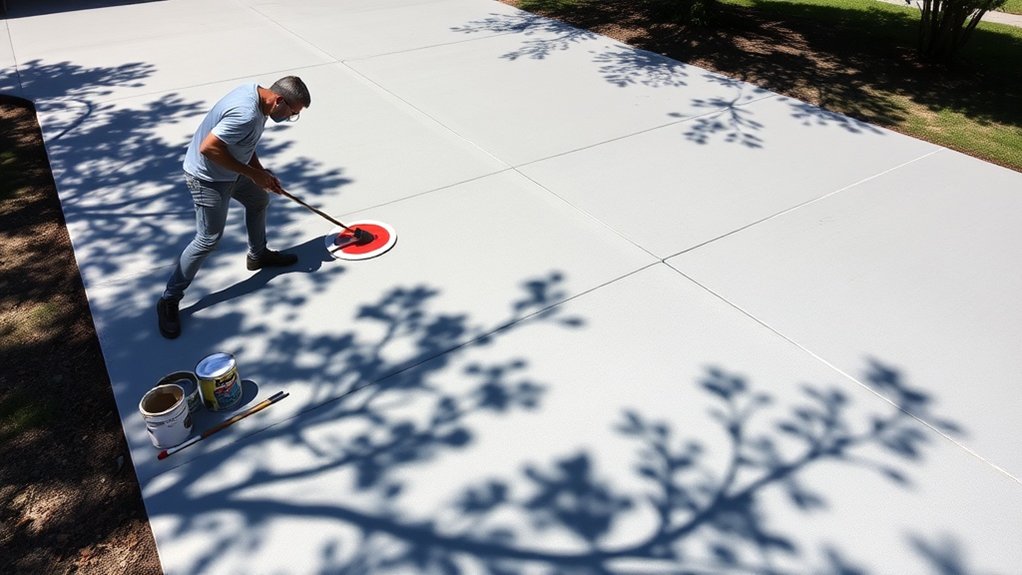
To achieve the best results when painting your concrete driveway, effective application techniques are crucial.
Start by thoroughly preparing the surface; clean it with a pressure washer and a suitable degreaser, and fill in any cracks or holes. Once the surface is dry, apply a concrete primer to ensure the paint adheres well.
Opt for high-quality masonry or epoxy paint, and choose your application method wisely—use rollers for intricate areas and sprayers for larger sections.
Work in small patches to maintain a wet edge, ensuring even coverage. Apply two coats, with the second coat going on crosswise to the first for added durability.
Environmental Considerations
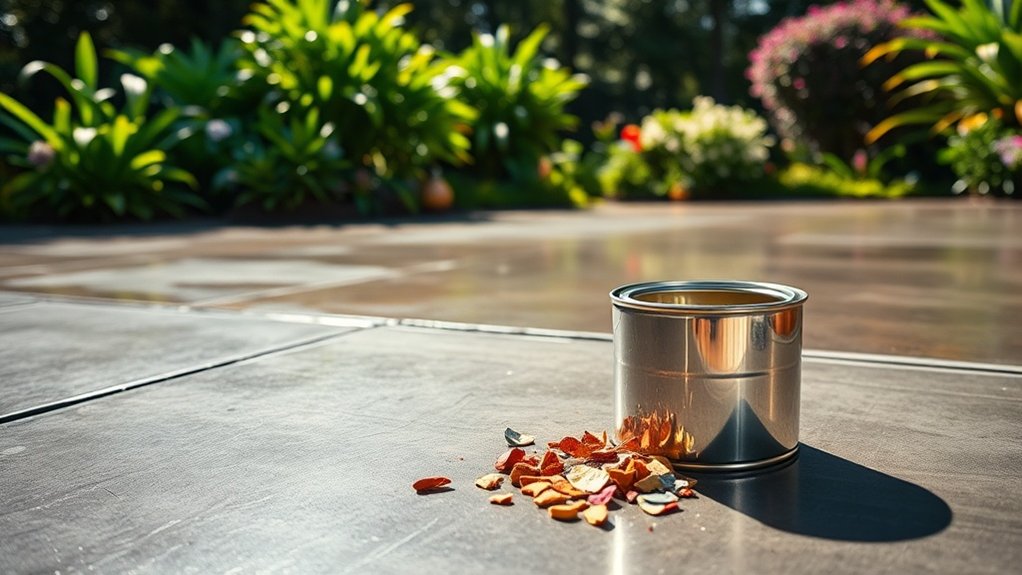
While painting your concrete driveway can improve its look and protect the surface, it’s important to consider the environmental effects of the materials and processes used.
Here are three key points to keep in mind:
- Chemical Emissions: Many traditional driveway paints contain volatile organic compounds (VOCs), which can lead to air pollution and contribute to climate change.
- Water Contamination: Rain can wash paint pollutants into local waterways, posing a threat to aquatic life and ecosystems.
- Sustainable Choices: Choosing low-VOC or eco-friendly paints can significantly reduce your environmental impact and promote healthier surroundings.
Potential Drawbacks of Painting
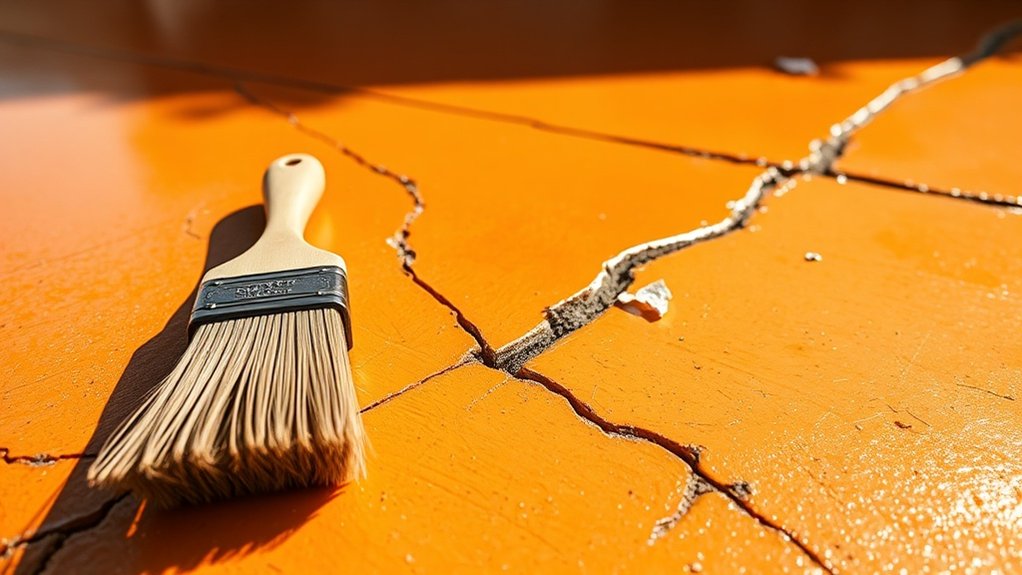
While painting your concrete driveway can improve its look, the drawbacks often outweigh the advantages. One major concern is the difficulty of application; achieving a strong bond with concrete is challenging due to its rough texture. Over time, paint can chip, flake, and peel, particularly in areas with heavy foot or vehicle traffic. Additionally, safety is a significant issue; wet painted surfaces can become very slippery, raising the risk of falls.
| Drawback | Description |
|---|---|
| Durability Issues | Paint tends to struggle to adhere properly, leading to chipping. |
| Safety Hazards | Wet surfaces can be dangerously slippery without the use of additives. |
| Aesthetic Limitations | Painted surfaces may look artificial and wear unevenly. |
| Labour Intensity | Proper application demands considerable preparation and effort. |
Maintenance Requirements
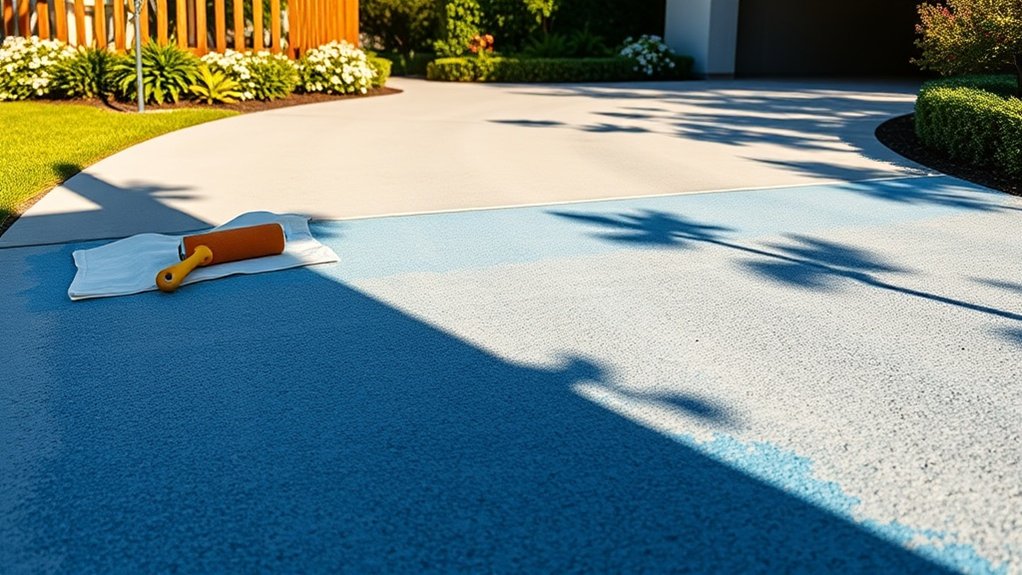
Maintaining a painted concrete driveway is crucial for keeping it looking good and functional, especially since painting can have some downsides. Here’s a straightforward maintenance routine to follow:
- Set a cleaning schedule: Regularly sweep the driveway and wash it down with a low-pressure hose to avoid dirt build-up and stains. Use mild detergents specifically formulated for concrete coatings.
- Check sealing frequency: Reseal your driveway every 2-3 years to protect it from moisture and UV damage. Always opt for high-quality sealants and follow the manufacturer’s instructions.
- Tackle stains quickly: If you spill oil or grease, clean it up immediately with gentle scrubbing agents. Rinse thoroughly to remove any residue that could hinder adhesion.
Alternatives to Painting a Concrete Driveway
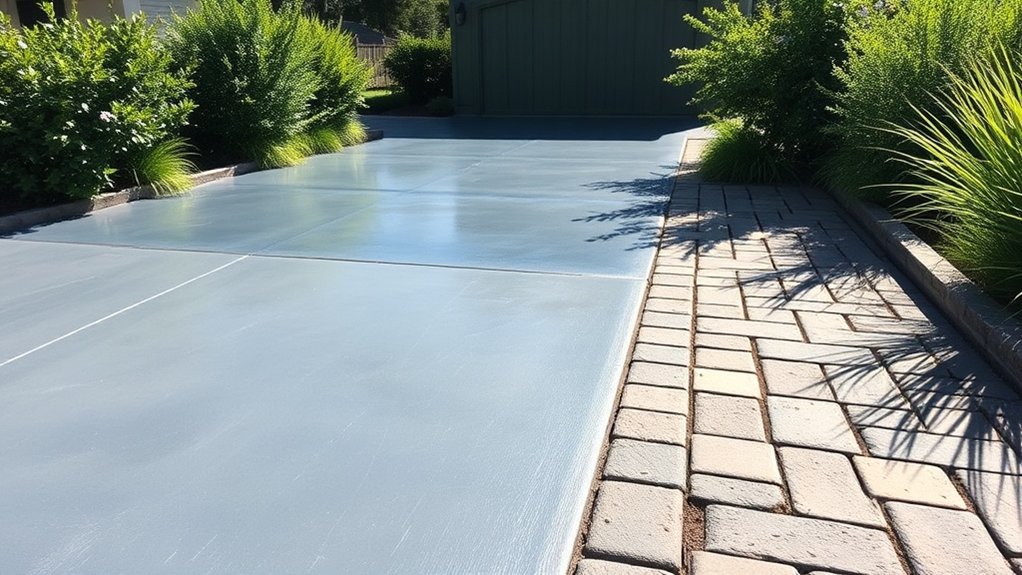
If you’re looking for alternatives to painting your concrete driveway, there are several options to improve its look and functionality.
Penetrating sealers provide invisible protection, maintaining the natural appearance while safeguarding against moisture and freeze-thaw damage.
For a decorative finish, you might try stamped concrete, which mimics the look of natural stone, or acid-stained concrete for vibrant, marbled effects.
Integral pigments can also create a consistent colour throughout the slab.
If you prefer a more rustic aesthetic, crushed stone is an attractive and budget-friendly choice, although it does require some upkeep to prevent displacement.
Lastly, pervious concrete is an eco-friendly option that allows water to seep through, helping to manage runoff and enhancing the overall appeal of your driveway.
Frequently Asked Questions
How Long Does Painted Concrete Typically Last Before Needing Maintenance?
Painted concrete usually lasts between 3 to 5 years before it requires maintenance. To ensure the paint lasts as long as possible, it’s advisable to follow a maintenance routine that includes annual cleaning and touch-ups every 1 to 3 years for optimal results.
Can I Use Regular Paint Instead of Concrete-Specific Paint?
No, you can’t use regular paint instead of concrete-specific paint. Standard paint isn’t durable enough and doesn’t adhere well. Concrete paint offers lasting protection and is resistant to wear, ensuring your driveway stays attractive and robust for years to come.
What Are the Best Tools for Painting a Concrete Driveway?
For painting a concrete driveway, use a 10mm nap roller for flat areas, angled brushes for edges, and paint sprayers for quick coverage. The right tools ensure a smooth finish and efficient application.
How Do I Remove Paint From a Concrete Driveway if Needed?
To remove paint from your concrete driveway, you can use heat guns or chemical strippers; these are effective options for paint removal. Always prioritise proper care for your concrete to ensure it remains in good condition while restoring its original appearance.
Is It Safe to Walk on the Driveway After Painting?
No, it’s not safe to walk on the driveway immediately after painting. Ensure you allow sufficient drying time and take safety precautions, such as checking for slippery surfaces, to avoid accidents during the curing process.
Conclusion
In summary, painting your concrete driveway can enhance its appearance and provide some protection. However, it’s crucial to consider the maintenance requirements and potential downsides against the visual benefits. As the saying goes, “a stitch in time saves nine”; putting in the effort now can prevent expensive repairs later. If you decide to go ahead, ensure you choose the right paint and properly prepare your surface for a vibrant, long-lasting finish.
How can a tarmac driveway enhance your home's appeal? Discover the key aspects of cost, installation, and maintenance in our Read more
Wondering if a tarmac driveway is the perfect fit for your home? Uncover the essential pros and cons before making Read more
Optimize your tarmac driveway's appearance with simple maintenance tips, but discover the crucial secrets that can extend its lifespan even Read more

